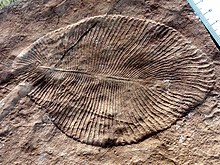Dickinsonia
|
Dickinsonia Temporal range: late Ediacaran, 558–555 Ma |
|
|---|---|
 |
|
| Cast of Dickinsonia costata from Australia | |
| Scientific classification | |
| Kingdom: | Animalia |
| Subkingdom: | Eumetazoa |
| Clade: | Bilateria |
| Family: | †Dickinsoniidae |
| Genus: |
†Dickinsonia Sprigg, 1947 |
| Species | |
|
See text |
|
| Synonyms | |
|
|
See text
Dickinsonia is a genus of iconic fossils of the Ediacaran biota. The individual Dickinsonia typically resembles a bilaterally symmetrical ribbed oval. Its affinities are presently unknown; its mode of growth is consistent with a bilaterian affinity, though some have suggested that it belongs to the fungi, or even an "extinct kingdom".
Dickinsonia fossils are known only in the form of imprints and casts in sandstone beds. The specimens found range from a few millimetres to about 1.4 metres (4 ft 7 in) in length, and from a fraction of a millimetre to a few millimetres thick.
They are nearly bilaterally symmetric, segmented, round or oval in outline, slightly expanded to one end (i.e. egg-shaped outline). The rib-like segments are radially inclined towards the wide and narrow ends, and the width and length of the segments increases towards the wide end of the fossil. The segments are separated by thin ridge or groove along the axis of symmetry into right and left halves. But left and right halves are organized in an alternating pattern according to glide reflection symmetry rather than bilateral symmetry; thus, these "segments" are isomers. This glide reflection is also found in Spriggina, another mysterious organism from approximately the same era.
The segments of Dickinsonia have been described as "pneus", chambers filled with a liquid at higher than ambient pressure, analogous to a quilted air mattress. Features in a few specimens have been interpreted as evidence of longitudinal muscle fibers, and a medial gut, but this interpretation has not reached acceptance.
Some spectacular fossils attributed to Dickinsonia appear to preserve internal anatomy, believed to represent a tract that both digested food and distributed it throughout the organism.
Similar fossils include Yorgia, which differs in having one end which is segment-free, variously interpreted as a head or hold fast. Another similar fossil is Rutgersella, in which the central groove does not extend to both ends as in Dickinsonia.
...
Wikipedia
